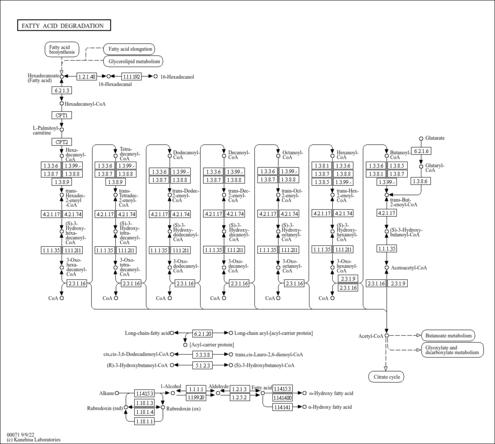| Identification |
|---|
| YMDB ID | YMDB00188 |
|---|
| Name | L-Carnitine |
|---|
| Species | Saccharomyces cerevisiae |
|---|
| Strain | Baker's yeast |
|---|
| Description | Carnitine is an ubiquitous compound biosynthetised from the amino acids lysine and methionine and involved in the transport of long-chain fatty acids. The active form is L-carnitine whereas D-carnitine is biologically inactive. Fatty acids are broken down to acetyl-CoA through beta-oxidation, which in yeast takes place exclusively in peroxisomes. Acetyl-CoA is then used in the glyoxylate cycle for gluconeogenesis and formation of carbohydrates, or transported to mitochondrion for the generation of metabolic energy through the citric acid cycle. [Biocyc PWY-6111] [PMID: 10545096] |
|---|
| Structure | |
|---|
| Synonyms | - (-)-(R)-3-Hydroxy-4-(trimethylammonio)butyrate
- (-)-carnitine
- (R)-(3-Carboxy-2-hydroxypropyl)trimethylammonium hydroxide
- (r)-carnitine
- (s)-carnitine
- 1-carnitine
- 3-carboxy-2-hydroxy-N,N,N-trimethyl-1-propanaminium
- 3-hydroxy-4-trimethylammoniobutanoate
- 3-hydroxy-4-trimethylammoniobutanoic acid
- Bicarnesine
- Carnilean
- Carnitene
- Carnitine
- Carnitor
- D-carnitine
- delta-carnitine
- DL-carnitine
- Gamma-trimethyl-ammonium-beta-hydroxybutirate
- Gamma-trimethyl-beta-hydroxybutyrobetaine
- Gamma-trimethyl-hydroxybutyrobetaine
- Karnitin
- L-(-)-carnitine
- L-carnitine
- L-gamma-trimethyl-beta-hydroxybutyrobetaine
- Levocarnitina
- Levocarnitine
- Levocarnitinum
- R-(-)-3-hydroxy-4-trimethylaminobutyrate
- Vitamin BT
- (+)-Carnitine
- Carnitine D-form
- D-(3-Carboxy-2-hydroxypropyl)trimethylammonium hydroxide, inner salt
|
|---|
| CAS number | 541-15-1 |
|---|
| Weight | Average: 161.1989
Monoisotopic: 161.105193351 |
|---|
| InChI Key | PHIQHXFUZVPYII-LURJTMIESA-N |
|---|
| InChI | InChI=1S/C7H15NO3/c1-8(2,3)5-6(9)4-7(10)11/h6,9H,4-5H2,1-3H3/t6-/m0/s1 |
|---|
| IUPAC Name | (3S)-3-hydroxy-4-(trimethylazaniumyl)butanoate |
|---|
| Traditional IUPAC Name | (+)-carnitine |
|---|
| Chemical Formula | C7H15NO3 |
|---|
| SMILES | [H]O[C@@]([H])(C([H])([H])C([O-])=O)C([H])([H])[N+](C([H])([H])[H])(C([H])([H])[H])C([H])([H])[H] |
|---|
| Chemical Taxonomy |
|---|
| Description | belongs to the class of organic compounds known as carnitines. These are organic compounds containing the quaternary ammonium compound carnitine. |
|---|
| Kingdom | Organic compounds |
|---|
| Super Class | Organic nitrogen compounds |
|---|
| Class | Organonitrogen compounds |
|---|
| Sub Class | Quaternary ammonium salts |
|---|
| Direct Parent | Carnitines |
|---|
| Alternative Parents | |
|---|
| Substituents | - Carnitine
- Beta-hydroxy acid
- Short-chain hydroxy acid
- Fatty acid
- Hydroxy acid
- Tetraalkylammonium salt
- 1,2-aminoalcohol
- Carboxylic acid salt
- Secondary alcohol
- Carboxylic acid derivative
- Carboxylic acid
- Monocarboxylic acid or derivatives
- Organic oxygen compound
- Organooxygen compound
- Organic zwitterion
- Organic salt
- Hydrocarbon derivative
- Organic oxide
- Carbonyl group
- Organopnictogen compound
- Amine
- Alcohol
- Aliphatic acyclic compound
|
|---|
| Molecular Framework | Aliphatic acyclic compounds |
|---|
| External Descriptors | |
|---|
| Physical Properties |
|---|
| State | Solid |
|---|
| Charge | 0 |
|---|
| Melting point | 197 °C |
|---|
| Experimental Properties | | Property | Value | Reference |
|---|
| Water Solubility | Not Available | PhysProp | | LogP | Not Available | PhysProp |
|
|---|
| Predicted Properties | |
|---|
| Biological Properties |
|---|
| Cellular Locations | - Cytoplasm, Extracellular, Mitochondrion, Peroxisome
|
|---|
| Organoleptic Properties | Not Available |
|---|
| SMPDB Pathways | |
|---|
| KEGG Pathways | |
|---|
| SMPDB Reactions | Not Available |
|---|
| KEGG Reactions | Not Available |
|---|
| Concentrations |
|---|
| Intracellular Concentrations | Not Available |
|---|
| Extracellular Concentrations | Not Available |
|---|
| Spectra |
|---|
| Spectra | | Spectrum Type | Description | Splash Key | View |
|---|
| Predicted GC-MS | Predicted GC-MS Spectrum - GC-MS (Non-derivatized) - 70eV, Positive | splash10-00di-9100000000-1b25dacb04c3ed5be8d0 | JSpectraViewer | | LC-MS/MS | LC-MS/MS Spectrum - Quattro_QQQ 10V, Positive (Annotated) | splash10-03di-2900000000-838e3352a967414a72b6 | JSpectraViewer | MoNA | | LC-MS/MS | LC-MS/MS Spectrum - Quattro_QQQ 25V, Positive (Annotated) | splash10-0pbl-9200000000-00392257546f220a99e6 | JSpectraViewer | MoNA | | LC-MS/MS | LC-MS/MS Spectrum - Quattro_QQQ 40V, Positive (Annotated) | splash10-0a4l-9000000000-f740371c8e6547d00caa | JSpectraViewer | MoNA | | LC-MS/MS | LC-MS/MS Spectrum - LC-ESI-QTOF (UPLC Q-Tof Premier, Waters) , Positive | splash10-03di-0900000000-c58323e2e9eb0d43afd4 | JSpectraViewer | MoNA | | LC-MS/MS | LC-MS/MS Spectrum - LC-ESI-QTOF (UPLC Q-Tof Premier, Waters) 30V, Positive | splash10-03di-0900000000-07916b6c77becc7b8c81 | JSpectraViewer | MoNA | | Predicted LC-MS/MS | Predicted LC-MS/MS Spectrum - 10V, Positive | splash10-01ox-0900000000-3bffd5143cf8b072299e | JSpectraViewer | | Predicted LC-MS/MS | Predicted LC-MS/MS Spectrum - 20V, Positive | splash10-00kf-0900000000-e68f553bcb15d3ef5b47 | JSpectraViewer | | Predicted LC-MS/MS | Predicted LC-MS/MS Spectrum - 40V, Positive | splash10-00di-9200000000-77b63d360e6d4a61dff3 | JSpectraViewer | | Predicted LC-MS/MS | Predicted LC-MS/MS Spectrum - 10V, Negative | splash10-03di-1900000000-dd1b1a023937cdcb11af | JSpectraViewer | | Predicted LC-MS/MS | Predicted LC-MS/MS Spectrum - 20V, Negative | splash10-114i-3900000000-2ec1dcd043005fc2eb27 | JSpectraViewer | | Predicted LC-MS/MS | Predicted LC-MS/MS Spectrum - 40V, Negative | splash10-0a4l-9000000000-07d7ea1192c1873ad80d | JSpectraViewer | | 1D NMR | 1H NMR Spectrum | Not Available | JSpectraViewer | | 1D NMR | 13C NMR Spectrum | Not Available | JSpectraViewer | | 2D NMR | [1H,1H] 2D NMR Spectrum | Not Available | JSpectraViewer | | 2D NMR | [1H,13C] 2D NMR Spectrum | Not Available | JSpectraViewer |
|
|---|
| References |
|---|
| References: | - UniProt Consortium (2011). "Ongoing and future developments at the Universal Protein Resource." Nucleic Acids Res 39:D214-D219.21051339
- Scheer, M., Grote, A., Chang, A., Schomburg, I., Munaretto, C., Rother, M., Sohngen, C., Stelzer, M., Thiele, J., Schomburg, D. (2011). "BRENDA, the enzyme information system in 2011." Nucleic Acids Res 39:D670-D676.21062828
|
|---|
| Synthesis Reference: | Bols, Mikael; Lundt, Inge; Pedersen, Christian. Simple synthesis of (R)-carnitine from D-galactono-1,4-lactone. Tetrahedron (1992), 48(2), 319-24. |
|---|
| External Links: | |
|---|

